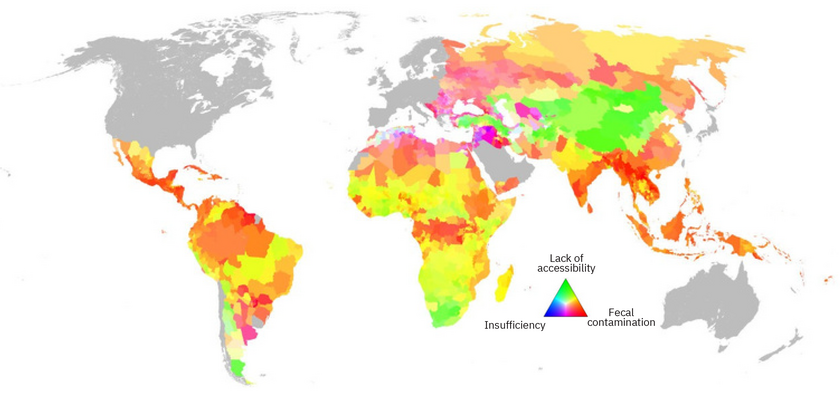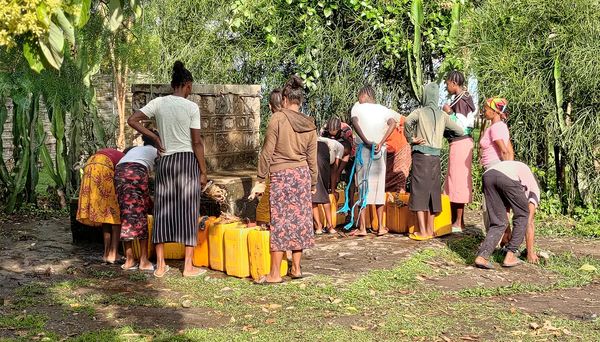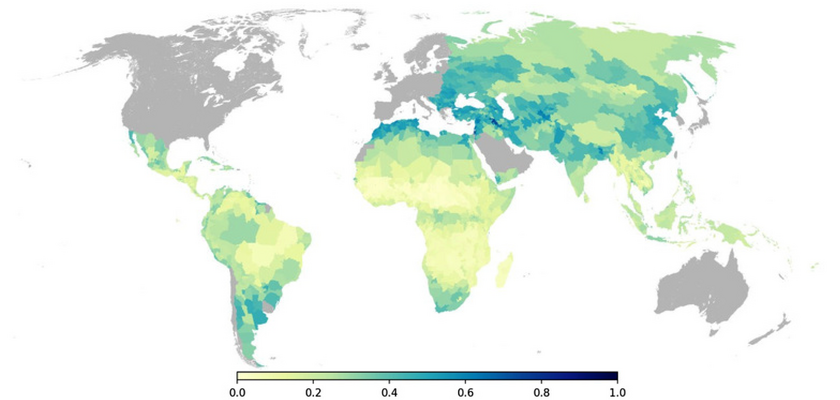News Detail
Four billion people estimated to lack safe drinking water services
August 15, 2024 |
Safe drinking water access is a human right and one of the United Nations' Sustainable Development Goals. However, data on the number of people using safely managed drinking water services is lacking for more than half of the world's population. "With our work we aim to help close this information gap," says Esther Greenwood, PhD student at Eawag and lead author of the study funded by the Swiss National Science Foundation, and published in the journal "Science". The researchers from Eawag with the support of ETH Zurich, United Nations Children’s Fund (UNICEF), World Health Organization (WHO), Swiss Tropical and Public Health Institute, and University of Basel developed models to estimate the use of safely managed drinking water services in 135 low- and middle-income countries (LMICS).
The models were developed using machine learning based on existing data sets from household surveys and data derived from Earth observations. A main finding of the study: only one in three people in LMICS countries used safely managed drinking water services in 2020. The study also found that fecal matter polluted the drinking water of almost half of the population in these countries, and a third of people needed to fetch water from a shared water point.
The global maps produced by the researchers show where the drinking water services are lacking: In rural areas of low-income countries with high temperatures and strong seasonal fluctuations in rainfall. The maps suggest that in several countries in sub-Saharan Africa less than 10% of the populations used safely managed drinking water. "We estimate that over four billion people worldwide do not use adequate drinking water services," summarizes Greenwood. This is a notable result because this figure is more than twice as high as the previous estimate of the WHO and UNICEF, which are responsible for monitoring drinking water in a joint program. "The number of people whose basic human right to safe drinking water is not being met may therefore be significantly underestimated," says the scientist.

Combining household survey and Earth observation data
For their study, the researchers used household survey data collected by UNICEF that includes information on over 60,000 households in 27 countries between 2016 and 2020. The researchers recorded what type of drinking water source the respondents use, where it is located, whether they have had to deal with water insufficiencies and whether the water was free from fecal contamination. The researchers also used geospatial data derived from satellite data, as well as airborne and land-based data which are available worldwide. "This approach is new in our field," says Greenwood: "We collaborated with researchers from Crowther Lab at ETH Zurich, who use Earth observation and other geodata sets to create global ecological models."
The availability, accessibility and quality of drinking water depend on various environmental and socio-economic factors. For example, climate, geology, vegetation, but also population density and the proportion of farmland, urban landcover and forest play a key role. "At the beginning, we were very generous and selected over 100 possible predicters that we believed could be relevant for safe drinking water because they are linked to the water cycle or relevant human factors such as urbanization,” explains Greenwood. The researchers then used machine learning to create a model, which they trained with the data on drinking water services from the household surveys. In further steps, they were able to reduce the number of predictors from 117 to 39.
"Our approach does not allow us to determine causes," says Greenwood: "but we can see, for example, that climate factors played the most important role in predicting microbial drinking water quality." This is in line with research findings that show that heavy rainfall or high temperatures can lead to increases in microbial contamination of drinking water, especially in low-income settings. On the other hand, human factors such as population density or the proportion of built-up area, were the most important predictors for determining how accessible the drinking water source was. And predicters that describe local vegetation were most important for predicting drinking water availability, suggesting that the lack of availability of water for plants is linked to drinking water availability for people.
Predictions calculated for 135 countries
The main model estimates the proportion of people in a particular region who use safely managed drinking water services in 2020. By combining globally available geospatial data sets with household surveys from 27 countries, predictions were calculated for 135 countries of which approximately half lacked any previous national estimates.
"The study shows how far away certain regions are from achieving universal access to safe drinking water," says Greenwood. She also hopes that the new findings will help to better understand the current situation worldwide and thus better plan and allocate financial resources. "I think our study can help raise awareness about the state of drinking water services in low- and middle- income countries and suggest where data collection and financial investments are needed to improve the situation."
Comments by Eawag Director Martin Ackermann on the study
"The fact that so many people around the world do not have reasonable access to safe drinking water must give us pause for thought. Long distances to the nearest water source and polluted water are the main reasons for much suffering and disease. This could be avoided. We at Eawag are pursuing two goals with our research.
Prevention: Water resources must be better protected. In many places there would be sufficient river or lake water, but it is so heavily polluted that it cannot be used as drinking water. Precautionary measures for drinking water also include adequate handling of wastewater, as inadequately treated wastewater or leaking sewerage systems are one of the main sources of water pollution.
Treatment: We must develop and disseminate methods that enable safe water treatment and distribution. They must also function under changing climatic conditions and constantly changing socio-political circumstances. In places where water is scarce, the recycling of slightly contaminated wastewater can also be a solution. This can also close regional material cycles."
Eawag research for safe drinking water services worldwide
With its research, Eawag contributes to achieving the 17 Sustainable Development Goals (SDGs) of the United Nations. First and foremost, our work naturally supports Goal 6: clean drinking water and sanitation. However, many research projects also contribute to the other goals. Find out more about our research for the SDGs and concrete projects that develop solutions to achieve access to safe and affordable drinking water for all. You can also find more information in our Eawag Info Day Magazine 2023 Aquatic Research for Sustainable Development and our websites Drinking Water - Maintaining the quality of drinking water and Water and Development - Safe drinking water and comprehensive sanitation.
Cover picture: People at a bono in Dulecha Tibirako, Ethiopia, collecting water to take home (Photo: Anna Wettlauffer).
Original publication
Cooperations
- Eawag
- Crowther Lab, ETH Zürich
- UNICEF
- WHO
- Schweizerischen Tropen- und Public-Health-Institut
- Universität Basel.


